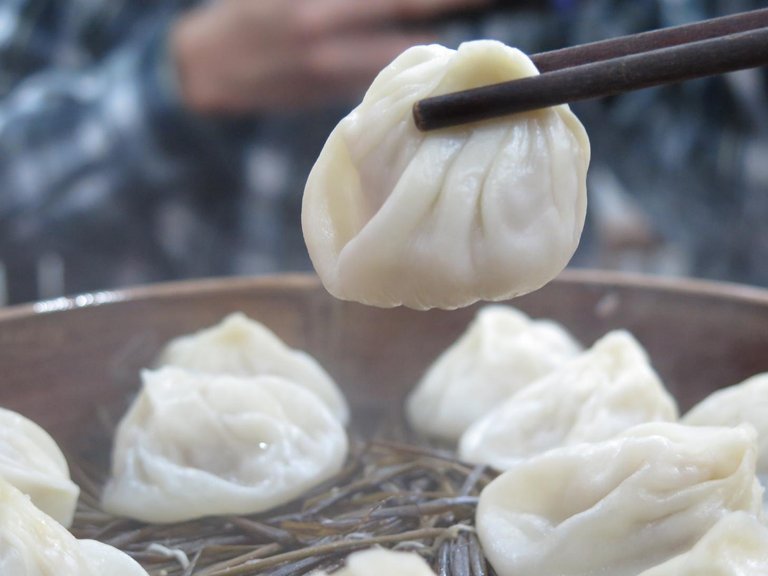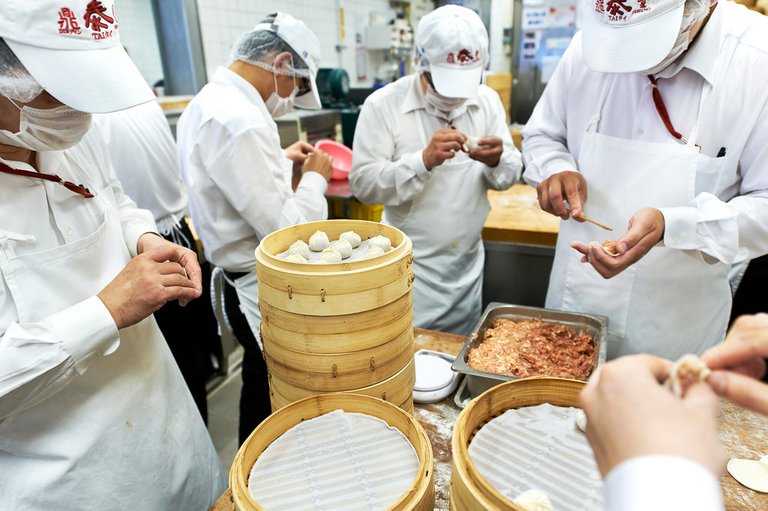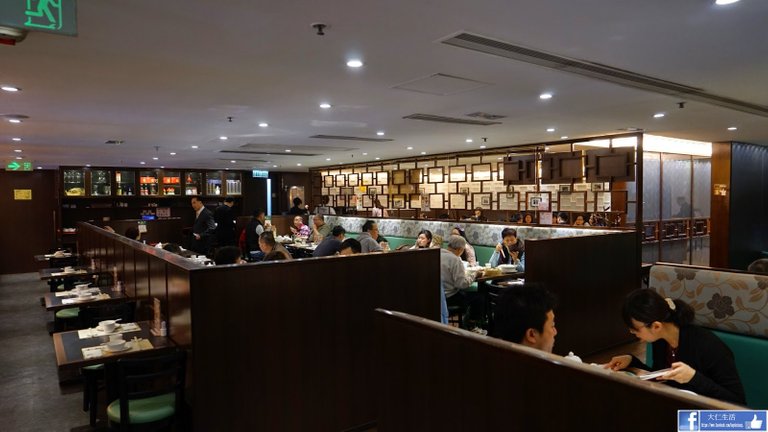 Linlongfang soup dumplings // 麟笼坊之小笼包
Linlongfang soup dumplings // 麟笼坊之小笼包New and old // 新与旧
Shanghai is experiencing a great war between the new and the old. I live in an area called Laoximen (“Old West Gate”) which still contains remnants of the western city walls of the Old City which were originally constructed in 1554. To the northwest of my apartment are People’s Square and Xintiandi (“New Heaven and Earth”), districts which contain a great of Shanghai’s luxury department stores; on the other hand, the southeastern areas possess a significant number of the Shanghai’s migrant worker population and the older housing they live in, which also contains much of Shanghai’s old history and customs. Fun fact: Einstein and his wife visited the Old City in 1922, where they received confirmation that he had won the Nobel prize. While there, they dined with the artist Wang Yiting who owned a villa that was built with European and Japanese structures combined; the building still stands and has been converted into shared housing units.
当代上海正在经历着新与旧之间的大战。我住的地方叫老西门,指的是上海老城西边建于1554年的城墙还现存的部分。位于我房子西北边的是人民广场和新天地,它们属于上海拥有许多奢侈百货大楼的区域;东南边却拥有不少的流动市民及大量破旧的房子,其中饱含上海的历史和传统。很有趣的故事:1922年爱因斯坦和他的太太访问上海时得到了诺贝尔奖的通知。著名艺术家王一亭邀请他们来在老城厢的别墅吃饭;别墅的建筑结构非常别致,含有欧洲和日本方式的设计,目前是共享老房子。
Shanghai’s Old City // 上海老城厢

Nanxiang Mantou Dian (YuYuan), courtesy of TripAdvisor
Aside from architecture, the battle between the new and old have another manifestation: food. Let’s begin with examining the historic sites. To the east of Laoximen lies the acclaimed Yu Gardens, constructed during the Ming Dynasty (construction began in 1559). Surrounding the Yu Gardens are the Old City, and within the Old City lies a restaurant that serves soup dumplings (a food Shanghai is most famous for): the Nanxiang Steamed Bun Restaurant. The location pictured here is the original restaurant, established in 1900. You’ll find long lines here all day every day, with a mix of foreigners and local tourists who think it’s worth the wait. When the Communist government took power in 1949, they took over the restaurant, and it continues to be a state-run enterprise. My Chinese teacher is Shanghainese, and recalls how his mother would take him to eat these soup dumplings; at that time, you could only buy baskets of 16. Now, you must pay 30+RMB ($5 USD) for 8 dumplings; a typical soup dumpling restaurant would charge half this price. Still, my teacher yearns for these nostalgic dumplings.
除了建筑之外,新与旧之间的大战还有一个表现:小吃。让我们首先从历史悠久的开始探索。老西门东边有建于明朝的豫园,是相当著名的园林。豫园外面就有上海老城厢,在老城厢区域内有闻名上海的小笼包店叫做南翔馒头店,这家总店创建于1900年。一年365日全天都排很长的队,外地人和当地人都觉得很值得。从1949年中国独立至今,这个餐厅都是由政府经营的。我的中文老师是个老上海人,妈妈从他小时候就开始带他去吃那家的小笼包;那个时候小笼包只能16个一卖,现在8个要30多块钱;是普通小笼包价格的两倍。老师现在还会怀念那种最典型的小笼包。
The Michelin Soup Dumpling // 米其林的小笼包
 Din Tai Fung in Taipei // 台北的鼎泰丰
Din Tai Fung in Taipei // 台北的鼎泰丰Justin Guariglia for The International Herald Tribune
Who is the rival of such traditional soup dumpling? It might just be the soup dumpling behemoth Din Tai Fung. Although I wouldn’t say they are direct competitors, in the eyes of non-Chinese gourmands, Din Tai Fung is the most renowned brand of soup dumplings. Its founder fled for Taiwan in 1948 during the Chinese Civil War; in 1970, he and his Hakka wife hired Shanghainese chefs to help them make soup dumplings. In 1993, the New York Times named their restaurant one of the top 10 restaurants in the world; in 2010, they earned a Michelin star. I’ve visited the original store in Taipei many times, and their queue is just as long as that of Nanxiang Steamed Bun’s in Shanghai. In Shanghai, Din Tai Fung’s branches are all within high-end department stores. Just east of my home here, in Xintiandi, there is a Din Tai Fung that is particularly popular among foreign tourists.
传统小笼包的对手是哪家呢?也许是鼎泰丰。虽然不是直接的竞争者,但我还认为鼎泰丰在外国人看来是最著名的中外小笼包品牌。鼎泰丰的创始人1948年国共内战的时候逃走到台湾;1970年他和太太一起开了一个小店,招聘了一些上海厨师帮他们做小笼包。1993年被纽约时报评为世界十大饭馆;2010年鼎泰丰获得了一颗米其林星。我去过台北总店的很多次,像南翔馒头店一样要排很长的队。鼎泰丰在上海开的分店都在很高大上百货公司里面。我家东边的新天地就有一家很受外国游客欢迎的鼎泰丰分店。
Gentrification of food // 食物的高档化
 An upgraded Nanxiang restaurant // 更新的南翔馒头店
An upgraded Nanxiang restaurant // 更新的南翔馒头店Image from 大仁生活
The reason for me to compare these two soup dumpling establishments is not so that I can declare one the winner. In fact, the two restaurants have much in common: their prices are not cheap, and they’ve even become multi-national chains. The food at each restaurant lives up to their reputations. The most significant difference can be seen in the level of gentrification or modernization that they have undergone. When you personally want to eat dumplings, would you go to the one where you must stand in a long line outside, or would you visit the one inside of Xintiandi’s impeccable malls?
我之所以把这两家做比较不是由于我要宣布哪个比较好吃。其实两家有很多相同的地方:食物都不算廉价,且都已经变成跨国连锁公司了。两家的小笼包味道都名副其实。最大的区别是他们所在的地方反映它们的高档化和现代化的程度。你想吃小笼包的时候,你会去在外面排很长的队呢,还是你要去新天地清洁的百货公司?
Each has their pros and cons. But in Shanghai, I’ve seen so many interesting places begin to disappear: the hole-in-the-wall restaurants and historic wet market of Zhaozhou Rd., the expat bars of Yongkang Rd., the street-side vendors of Shouning Rd. I trust that the government will protect the sanctity of the old Nanxiang restaurant, but even that chain’s new restaurants are all built within department stores. This may have been a decision to commercialize their product, enhance service, and improve hygiene; few people would dislike such improvements. Modernization is not at all the opposite of tradition. They can and should co-exist. I simply hope that as we frequent mall food courts to eat, that we don’t forget to also support those old restaurants that have tradition, history, and character. As a foreigner, I also encourage tourists to seek out local hole-in-the-wall restaurants, instead of staying within the comfort zone of Michelin stars.
各有千秋。但我最近看到上海不少有味道的地方渐渐地消失,比如肇周路的小吃店和114岁的唐家湾菜场,永康路的酒吧,还有寿宁路路上的夜宵店。我相信上海政府会保护南翔小笼包的老店,但即使它们新开的分店都在百货公司里面。可能这就出于商业的目的,服务提高了,环境清洁了,很少有人不喜欢这种改善。现代化并不总是和传统对立,因为事实上它们可以一起共存。我就是希望我们去百货公司吃饭的同时不要忘记多支持很有传统,很有历史,很有味道的一些老店。作为一个老外,我也鼓励游客多去寻找当地的小餐厅,不要一直生活在米其林星的舒适区内。
P.S. Shameless plug and recommendations: In order to help foreign tourists experience China’s unique local foods, I became a tour guide with UntourFoodTours.com a year ago (we're #1 on TripAdvisor!), and I co-founded a food blog called Pian.eats on Instagram (the name is a cheesy pun meaning “Cheap eats”). In fact, the soup dumpling restaurant I personally recommend in my blog is neither of the two restaurants mentioned above, but it is also in the Laoximen area. It’s called Linlongfang (“Unicorn Basket Workshop”), and I captured the header image at the top of this post at their restaurant. They are the sister restaurant to the tourist-swarmed Jiajiatangbao in People’s square. Let me know next time if you’re in Shanghai and I’ll take you :)
P.S. 另外: 为了帮助外国游客多体验中国的一些独特美食,我一年前变成了UntourFoodTours.com的一个导游 ([TripAdvisor上排第一名!),也开始了自己关于上海廉价美食的博客叫做 Pian.eats (在IG上,因此需要翻墙)。我最强烈推荐的小笼包店不是上面写的两家,但也位于老西门附近。叫做 麟笼坊特色小笼包。这个文章头像就是那家的。他们是著名的佳家汤包的姐妹店。 下次你来上海,我就带你去吧 :)

以前在上海呆过,吃过南翔小笼包,头一次吃的时候,汤汁烫坏我了。下次就去你推荐的地方尝尝。我刚来steemit,关注你了,以后互相支持
哎哟,吃小笼包确实是要技巧的哈哈。欢迎你回来上海找我,我可以带你去那家!谢谢您的关注和支持,我也关注你了🙏💪
Congratulations @abroadlife!
Your post was mentioned in the hit parade in the following category:
Very cool way to aggregate content, thank you!
"What should we eat in Shanghai? I'll check the guide."
"But I don't want somewhere touristy, let's ask the locals."
"Good idea, we'll try something more authentic and then blog/yelp about it."
"Ooh, I hope it gets picked up by a guide."
The commodification of 'authentic culture' (which is really just daily life to those living it) is a real tricky thing. Even the most seemingly innocuous steps of a local market product entering the global market will drastically transform the nature of it... thus contradicting the original desire to trace out 'the authentic.'
ㅠㅠ
Right, there is an inherent contradiction in taking the "authentic" and leveraging it to drive expansion beyond the local. The trend in China is to invest/acquire foreign brands, with billions invested in German and Italian brands. The benefit is that Chinese firms can gain advanced technical expertise and brand heritage, while bringing down costs (especially for goods like cars and even pianos), but of course this also can produce anxiety for those that feel China is taking over their national industries. So companies are incentivized to promote the European heritage while "modernizing" the actual heritage of production.
Again, I think both can co-exist; just as we can have the "original" Din Tai Fung with its department store version, a piano maker can have its German-made version as well as the Chinese version. For example, New Balance segments their shoes, with 25% made in USA (and marketed as maintaining that heritage) while the rest are made overseas and sold at lower prices.
This is some scholarly Dumpling research @abroadlife! The food gentry is a huge problem in NYC (Manhattan) as well. I've seen many of my favorite hole in the wall establishments get muscled out just in the past few years. It's scary. But there's also this food-truck renaissance happening now where young chefs are taking their high-level craft to trucks (is mobility the new brick and mortar?) I'm curious to see how it all plays out!
Thanks for sharing this.
During my last trip to NYC, I was fascinated to see how vast the gap was between gentrified food and the local traditions they came from. Jianbing is a Chinese-style savory crepe, ubiquitous in Beijing and can be found all over China as a quick breakfast or late-night snack. In the Chinese immigrant communities of Flushing, Jianbing is about $3.50 USD, and then in Manhattan food trucks/Brookyn's Smorgasburg, you can find gourmet versions for $10+. In Shanghai stalls, they're usually around $1USD or 6RMB.
This is not to say that they're all the same product, and gentrified foods have their own markets. The question is, are they developed to respect and celebrate the cultures they come from, or are they exploiting the veneer of "cultural authenticity" for personal profit? There has been healthy debate on the topic in the case of Rick Bayless and his award-winning Mexican restaurants. Or check out the non-Korean American guy making craft soju in Brookyln after studying in Korea. Is this phenomenon any different than a Chinese guy who opens up a cheese shop in Beijing?
My take on this is that American society does not do a sufficient job of celebrating and promoting the food cultures immigrants. We should be questioning why there are not more cultural ambassadors who are from those cultures; is it their inability to see/promote the value of their own cultural assets, or is it that we only trust and give awards to ambassadors who have the right connections? I don't think there's a definitive answer either way, but at the least we can empower more members of immigrant communities to preserve and promote their heritage.
In East Asia, the idea of modernization resonates with western style a lot of times. And when it comes to restaurants, many places try to adapt to westernized service to 'modernize.' It can be good but most of times, this pushes away the cultural meaning of good service that they had provided for centuries. In Korea, good service once meant giving a customer more than what they had ordered (lots of 반찬, or 국... you know the Korean way), not necessarily smiling at a customer while serving or catering to a customer's need. Every culture has their own ways of providing food and good service. When you are ready to experience that, you can really taste the originality as well... I think a government can protect an old, traditional restaurant to a certain extent but in a long term, our attitude, the way we experience culture should change. We should never try to evaluate a place or suggest an improvement based on good service that we are accustomed to in our own culture. Accepting a way of life that is different than our own takes a lot of courage and discomfort but from there, we experience something truly valuable and unforgettable...like really good soup dumplings. =D Thank you for a good read!
Yes, that's a really good point! I didn't discuss the cultural element as much, but I think it's certainly embedded in how we evaluate a good restaurant. The Michelin Guide came to mainland China for the first time last year (itself a reflection of bias?) and received criticism for its preference of Hong-Kong/Cantonese restaurants over local cuisines and chefs, and its reliance on foreign inspectors who were not familiar with the local food scene. The Michelin inspectors certainly have cultural expectations embedded in their evaluation rubrics, whether it's taste, service, restaurant experience, attitude towards traditional foods, etc. These are traditions with heritage that is difficult to comprehend if you are not an insider.
Another element to consider is whether collectivism or group mentality affects our experience of restaurants. Asian consumers are known to have a remarkable tolerance for long lines, whether its lining up for Shake Shack months after its launch in Seoul, or waiting hours for a cup of "cheese" tea in China. This probably has to do with long lines signaling high value of the product, or the "bragging rights" and mob psychology of being able to "foodstagram" something that is scarce. This happens in New York as well with Cronuts, and with Franklin Barbecue in Texas. There's research that suggests that long wait times can increase consumer satisfaction based on consumption motivations, and it seems to me that consumption motivations are largely dependant on cultural values.
Thank you for reading and thanks your insight!
I want try this :)
It's a really special dish! I forgot to mention above: in order to get the soup inside, you take the gelatinous ingredients (pig/chicken bones, skin, feet), cooking it into a stock, then chilling it to form a "jelly" that is rich in collagen. Then you can mince it up, mix it with the filling, and when the dumplings get steamed, the "jelly" melts. When you eat it, you take small bite of the dumpling, let the steam escape, slurp out the soup, and then eat the rest of the dumpling whole. That's how you get the soup into a soup dumpling :)
Ok I will remember that :) Or I go and make it here :)
I’m missing an original recipe from you:P Also is there anything that the corrupt government didn’t fuck over with? I’m afraid not:/
Congratulations @abroadlife! You have completed some achievement on Steemit and have been rewarded with new badge(s) :
Click on any badge to view your own Board of Honor on SteemitBoard.
For more information about SteemitBoard, click here
If you no longer want to receive notifications, reply to this comment with the word
STOP